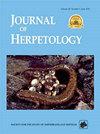Going Underground: What the Natural History Traits of Cave Users Can Tell Us about Cave Use Propensity
IF 0.8
4区 生物学
Q3 ZOOLOGY
引用次数: 2
Abstract
Abstract. Amphibians and reptiles use caves in different lithologies and biomes. However, the ecological reasons for such behavior have so far not been investigated in a broad scale. We surveyed 945 Brazilian caves in three biomes (Caatinga, Cerrado, and the Amazon), from which 269 had frogs and reptiles. We classified species of amphibians (34) and reptiles (19) according to natural history traits including habit, activity, diet composition, foraging strategy, and developmental mode (anurans). We used IUCN species distribution maps to predict what species occur in the vicinities of the caves but did not use them to test whether specific life history traits were distributed differently between species using and not using caves. We also tested seasonality and occurrence of bodies of water inside caves used by anurans, as well as the area occupied by man-made building and infrastructure around caves as explanatory factors for cave use intensity. Anurans with direct development were more likely to use caves than those with a tadpole stage. Terrestrial anurans were more likely to use caves than arboreal and semiarboreal anurans. No fossorial, semifossorial, or semiaquatic species used caves. Among reptiles, sit-and-wait foragers were more likely to use caves than active foragers. Semiaquatic and terrestrial reptiles were the most likely to use caves. Anurans were most likely to use caves with perennial bodies of water and during the dry season. Our results indicate that species of the herpetofauna are likely to search for resources in the cave habitat as indicated by the relationship between specific life history traits and cave use.走向地下:洞穴使用者的自然历史特征可以告诉我们洞穴使用倾向
摘要两栖动物和爬行动物在不同的岩性和生物群落中使用洞穴。然而,到目前为止,这种行为的生态原因还没有得到广泛的调查。我们调查了三个生物群落(Caatinga、Cerrado和亚马逊)的945个巴西洞穴,其中269个洞穴中有青蛙和爬行动物。我们根据自然历史特征,包括习性、活动、饮食组成、觅食策略和发育模式,对两栖动物(34)和爬行动物(19)进行了分类。我们使用国际自然保护联盟的物种分布图来预测洞穴附近的物种,但没有使用它们来测试使用洞穴和不使用洞穴的物种之间的特定生活史特征分布是否不同。我们还测试了阿努兰人使用的洞穴内水体的季节性和出现情况,以及洞穴周围人造建筑和基础设施占用的面积,作为洞穴使用强度的解释因素。与有蝌蚪阶段的Anurans相比,有直接发育的Anuran更有可能使用洞穴。陆生无尾虫比树栖和半树栖无尾虫更有可能使用洞穴。没有化石、半化石或半水生物种使用洞穴。在爬行动物中,坐以待毙的觅食者比活跃的觅食者更有可能使用洞穴。半水生和陆生爬行动物最有可能使用洞穴。Anurans最有可能在旱季使用有常年水体的洞穴。我们的研究结果表明,特定的生活史特征和洞穴使用之间的关系表明,疱疹动物物种可能会在洞穴栖息地寻找资源。
本文章由计算机程序翻译,如有差异,请以英文原文为准。
求助全文
约1分钟内获得全文
求助全文
来源期刊

Journal of Herpetology
生物-动物学
CiteScore
1.60
自引率
0.00%
发文量
45
审稿时长
6 months
期刊介绍:
The Journal of Herpetology accepts manuscripts on all aspects on the biology of amphibians and reptiles including their behavior, conservation, ecology, morphology, physiology, and systematics, as well as herpetological education. We encourage authors to submit manuscripts that are data-driven and rigorous tests of hypotheses, or provide thorough descriptions of novel taxa (living or fossil). Topics may address theoretical issues in a thoughtful, quantitative way. Reviews and policy papers that provide new insight on the herpetological sciences are also welcome, but they must be more than simple literature reviews. These papers must have a central focus that propose a new argument for understanding a concept or a new approach for answering a question or solving a problem. Focus sections that combine papers on related topics are normally determined by the Editors. Publication in the Long-Term Perspectives section is by invitation only. Papers on captive breeding, new techniques or sampling methods, anecdotal or isolated natural history observations, geographic range extensions, and essays should be submitted to our sister journal, Herpetological Review.
 求助内容:
求助内容: 应助结果提醒方式:
应助结果提醒方式:


